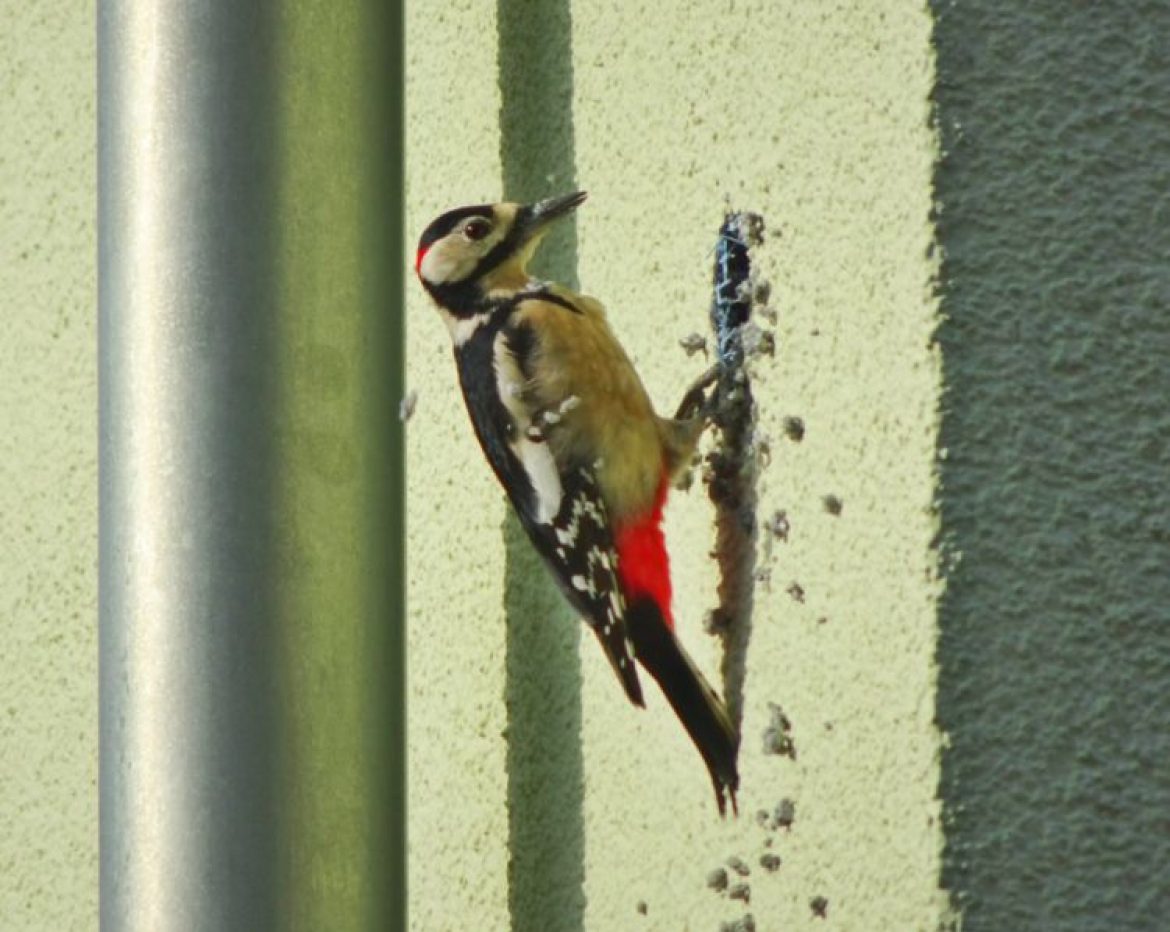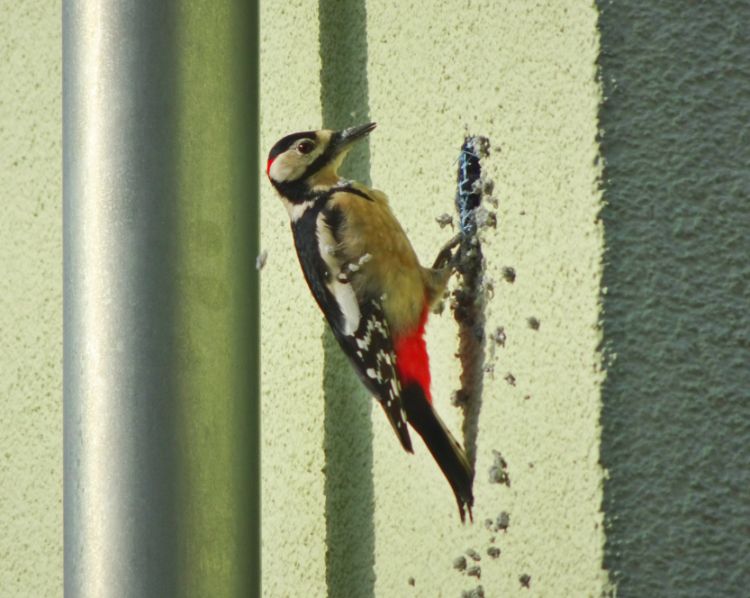Why Woodpeckers Love Siding and How to Prevent Them from Destroying Your House

 Your home is your castle, your refuge, and one of the best places to create memories. Just the sight of your dwelling as you round the bend after work can bring relief. So when the local woodpeckers decide to feast on your siding with what seems to be a sense of entitlement, it can be not only annoying, but damaging to the protective exterior of your home.
Your home is your castle, your refuge, and one of the best places to create memories. Just the sight of your dwelling as you round the bend after work can bring relief. So when the local woodpeckers decide to feast on your siding with what seems to be a sense of entitlement, it can be not only annoying, but damaging to the protective exterior of your home.
Woodpeckers are migratory, nongame birds protected by the Federal Migratory Bird Treaty Act, and commonly protected under state laws. When woodpeckers cause siding damage, it can go undetected until it is serious, particularly in summer vacation homes that are often unattended.
Why do woodpeckers choose to peck holes in your Colorado home’s siding?
- To attract a mate and claim their territory. The trouble is, this can go on for generations once they find a suitable location. And if that location is your home exterior, it’s time to create a sound plan to prevent it from reoccurring.
- To create a nesting cavity. Woodpeckers create large round holes in exterior siding for breeding purposes.
- To feed on insects living in your siding. You’ll need to hire an exterminator to treat the root problem of insect infestation to stop woodpeckers from damaging your siding.
- To store their food. Acorn Woodpeckers drill several closely spaced holes large enough to hold one acorn each. They are known to wedge acorns beneath roof shakes and fill unscreened plumbing vents with acorns.
What type of siding is easily damaged by woodpeckers?
Some siding types are more susceptible than others when it comes to woodpecker damage.
Wood siding
Homes with wood siding are extremely vulnerable to woodpecker damage. Woodpeckers damage redwood siding, pine, fir, cypress, natural, or stained wood surfaces. Various types of damage can occur with wood siding:
- Large holes due to woodpecker drumming, roosting or nesting
- Rows of small holes where woodpeckers are looking for insects
- Facia board woodpecker damage in the form of lots of small holes in groups—from drumming.
Cedar Clapboard siding
Home exteriors with cedar clapboards stained in earth tones such as brown, red, and green are all appealing to woodpeckers, and can be highly susceptible to woodpecker damage. If the home is painted in white or pastels, it’s less appealing to woodpeckers.
Cedar Shake siding
When it comes to woodpecker damage, this is an easily targeted siding option. From drumming to nesting and insect foraging, woodpecker damage is probable with cedar shake and cedar shingles.
Tongue and Groove Cedar siding
Woodpeckers go for the seams in this siding type, so beware of the possibility of small, medium, and even large holes at the seams.
Wood Composite siding
Wood composite siding is less attractive to woodpeckers, so their primary damage may be due to the woodpecker drumming.
Vinyl siding
Vinyl is not an attractive material to woodpeckers, but your home’s fascia boards are wood, and they can be targets for woodpecker damage.
How to stop woodpecker damage
Stop woodpecker damage by choosing an exterior siding material that prevents damage. Here are some winners to consider:
Fiber Cement Siding
James Hardie® Fiber Cement Siding offers homeowners a long-lasting, practical solution to prevent woodpecker damage to your home exterior.
Stone siding
Woodpeckers love hollow spaces, so stone siding offers them nothing that they are looking for. It’s a sizable investment, and your facia, trim, and chimney may still be appealing to woodpeckers even if you have stone elements on your home exterior.
Brick
This is one of the highest priced options, and not a typical remodel when looking to rid your home of woodpeckers, but it is something to weigh for a future move.
How James Hardie siding can prevent woodpecker damage in the future
Siding is vulnerable to nature’s elements and pests 24/7, so it’s wise to install replacement siding that holds up under harsh weather elements and resists unwanted insects and even woodpeckers! Here’s why Colorado Springs homeowners enjoy James Hardie fiber cement siding:
1. Avoid woodpecker and insect damage
Unlike wood siding (which woodpeckers can easily damage), James Hardie fiber cement siding is engineered to be unappealing to pests—including termites. Avoid the hassle of woodpecker damage or pest infestation with this trusted siding product.
2. Get attractive curb appeal
The color options and variety of style options give you beautiful selections from which to choose to match your style. With eye-catching curb appeal, you’ll love the look of James Hardie siding.
3. Enjoy long-lasting color
James Hardie’s ColorPlus® Technology offers homeowners baked-on color that resists fading and keeps your siding looking great with minimum maintenance. And ColorPlus® technology resists fading, so there’s no need to repaint it.
4. Savor superior performance
Weather tests the durability of siding year-round. Your choice of siding, along with proper installation, helps your home hold up during extreme temperatures, but it also resists deteriorating due to the impact of hail, moisture damage, rotting, unattractive warping, and the abrupt change of seasons. James Hardie siding is resistant to harsh weather elements such as excessive rain, snow, and ice storms.
5. Protect your loved ones with fire-resistant siding
Unlike wood or vinyl siding, James Hardie siding is resistant to flames and damaging heat, so it doesn’t contribute to fueling a fire. Due to its non-combustible makeup, insurance companies offer discounts to homeowners with James Hardie siding.
6. Get customized siding for your Colorado Springs home
James Hardie products are made to meet the needs our particular climate demands. Climate has a long-term effect on siding, so James Hardie created the HardieZone® system, which ensures you get the optimal product for Colorado’s climate. HZ5® products resist wet, below-freezing weather conditions, and are optimal for the Colorado Springs area.
Siding Pro specializes in James Hardie siding installation. See our James Hardie Siding installation services and get a quote.






